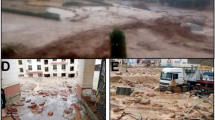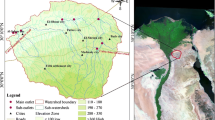Abstract
Flash floods are considered as catastrophic phenomena possessing major hazardous threat to the coastal cities, towns, villages and infrastructures. This study deals with the evaluation of flash flood hazard in the ungauged Wadi Al Lith basin depending on detailed morphometric characteristics of Al Lith basin and its sub-basins. For the detailed study, ASTER data were used for preparing digital elevation model (DEM), and geographical information system (GIS) was used in the evaluation of linear, areal and relief aspects of morphometric parameters. The major parameters such as watershed boundary, flow accumulation, flow direction, flow length and stream ordering are prepared using the ArcHydro Tool. Surface Tool in ArcGIS-10 software, and ASTER (DEM) was used to create different thematic maps such as DEM, contour, slope aspect and hill shade maps. Twenty-five morphometric parameters were measured, calculated and interlinked to produce nine effective parameters for evaluation of the flash flood hazard degree of the study area. Based on nine morphometric parameters which affect the hydrologic behaviour of the Wadi, by influence on time of concentration which has a direct influence on flooding prone area. The flash flood hazard of the Al Lith basin and its sub-basins was identified and classified into three groups (high, medium and low hazard degree). The study provides details on the flash flood-prone area (Wadi Al Lith) and the mitigation measures. This study also helps to plan rainwater harvesting and watershed management in the flash flood alert zones.








Similar content being viewed by others
References
Al Saud M (2009) Morphometric analysis of Wadi Aurnah drainage system, Western Arabian Peninsula. Open Hydrol J 3:1–10
Bapalu GV, Sinha, R (2005) GIS in flood hazard mapping: a case study of Kosi River Basin, India. GIS Development Weekly, 1(13):1–3. http://www.gisdevelopment.net/application/natural_hazards/floods. Accessed on 10 October 2008
Davis JC (1975) Statics and data analysis in geology. Wiley, New York
Fernandez D, Lutz M (2010) Urban flood hazard zoning in Tucumán Province, Argentina, using GIS and multicriteria decision analysis. Eng Geol 111(1–4):90–99
Gardiner V (1990) Drainage basin morphometry. In: Goudie A (ed) Geomorphological techniques. Unwin Hyman, London, pp 71–81
Gregory KJ, Walling DE (1973) Drainage basin form and process. Wiley, New York, 456
Guzzetti F, Tonelli G (2004) Information system on hydrological and geomorphological catastrophes in Italy (SICI): a tool for managing landslide and flood hazards. Nat Hazards Earth Syst Sci 4:213–232
Hagget P (1956) Locational analysis in human geography. Edward Arnold Ltd, London, 339
He YP, Xie H, Cui P, Wei FQ, Zhong DL, Gardner JS (2003) GIS-based hazard mapping and zonation of debris flows in Xiaojiang Basin, southwestern China. Environ Geol 45(2):286–293
Horton RE (1932) Drainage basin characteristics. Trans Am Geophys Union 13:350–361
Horton RE (1945) Erosional development of streams and their drainage basins, hydrophysical approach to quantitative morphology. Geol Soc Am Bull 56:275–370
Macka Z (2001) Determination of texture of topography from large scale contour maps. Geografski Vestnik 73(2):53–62
Maidment DR (2002) ArcHydro GIS for water resources. ESRI Press, California
Majure JJ, Soenksen, PJ (1991) Using a geographic information system to determine physical basin characteristics for use in flood-frequency equations. In: Balthrop BH, Terry JE (eds), U.S. Geological Survey National Computer Technology Meeting-Proceedings, Phoenix, Arizona, November 14–18, 1988: U.S. Geological Survey Water-Resources Investigations Report 90–4162: 31–40
Melton MA (1957) An analysis of the relation among elements of climate, surface properties and geomorphology. Technical Office of National Research, project NR Columbia University. 389–642
Merzi N, Aktas MT (2000) Geographic information systems (GIS) for the determination of inundation maps of Lake Mogan. Turkey Water Int 25(3):474–480
Miller VG (1953) A quantitative geomorphic study of the drainage basin characteristics in the Clinch Mountain area, Virginia and Tennessee. Colombia University, Geology Dept., Project NR 389-042, Technical Report No. (3):30
Nageswararao K, Swarna LP, Arun KP, Hari KM (2010) Morphometric analysis of Gostani River Basin in Andhra Pradesh State, India using spatial information technology. Int J Geom Geosci 1(2):79–187
Patton PC (1988) Drainage basin morphometry and floods. In: Baker VR et al (eds) Flood geomorphology. Wiley, New York, pp 51–65
Rudriaih M, Govindaiah S, Srinivas Vittala S (2008) Morphometry using remote sensing techniques in the sub-basins of Kagna River Basin, Gulburga District, Karnataka, India. J Indian Soc Remote Sens 36(12):351–360
Sanyal J, Lu X (2006) GIS-based flood hazard mapping at different administrative scales: a case study in Gangetic West Bengal, India. Singap J Trop Geogr 27:207–220
Schumm SA (1956) Evolution of drainage systems and slopes in badlands at Perth Amboy. New Jersey Bull Geol Soc Am 67:597–646
Şen Z, Khiyami AH, Al-Harthy SG, Al-Ammawi FA, Al-Balkhi AB, Al-Zahrani MI, Al-Hawsawy HM (2012) Flash flood inundation map preparation for wadis in arid regions. Arab J Geosci. doi:10.1007/s12517-012-0614-6
Subyani AM (2009) Hydrologic behavior and flood probability for selected arid basins in Makkah area, western Saudi Arabia. Arab J Geosci. doi:10.1007/s12517-009-0098-1
Strahler AN (1953) Revision of Horons' quantitative factors in erosional terrain. Trans Am Geophys U 34:356
Strahler AN (1957) Quantitative analysis of watershed geomorphology. Trans Am Geophys Union 38:913–920
Strahler AN (1964) Quantitative geomorphology of drainage basins and channel networks, handbook of applied hydrology. McGraw-Hill, New York, p 411
Sui DZ, Maggio RC (1999) Integrating GIS with hydrological modeling: practices, problems, and prospects. Comp, Environ Urban Sys 23:33–51
Toy TJ, Hadley RF (1987) Geomorphology and reclamation of distributed lands. Academic press, Inc. John Wiley and Sons, New York, pp 289–343
Zerger A, Smith DI (2003) Impediments to using GIS for real-time disaster decision support. Comp, Environ Urban Sys 27:123–141
Author information
Authors and Affiliations
Corresponding author
Rights and permissions
About this article
Cite this article
Bajabaa, S., Masoud, M. & Al-Amri, N. Flash flood hazard mapping based on quantitative hydrology, geomorphology and GIS techniques (case study of Wadi Al Lith, Saudi Arabia). Arab J Geosci 7, 2469–2481 (2014). https://doi.org/10.1007/s12517-013-0941-2
Received:
Accepted:
Published:
Issue Date:
DOI: https://doi.org/10.1007/s12517-013-0941-2




